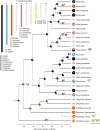A rapid rate of sex-chromosome turnover and non-random transitions in true frogs
- PMID: 30291233
- PMCID: PMC6173717
- DOI: 10.1038/s41467-018-06517-2
A rapid rate of sex-chromosome turnover and non-random transitions in true frogs
Abstract
The canonical model of sex-chromosome evolution predicts that, as recombination is suppressed along sex chromosomes, gametologs will progressively differentiate, eventually becoming heteromorphic. However, there are numerous examples of homomorphic sex chromosomes across the tree of life. This homomorphy has been suggested to result from frequent sex-chromosome turnovers, yet we know little about which forces drive them. Here, we describe an extremely fast rate of turnover among 28 species of Ranidae. Transitions are not random, but converge on several chromosomes, potentially due to genes they harbour. Transitions also preserve the ancestral pattern of male heterogamety, in line with the 'hot-potato' model of sex-chromosome transitions, suggesting a key role for mutation-load accumulation in non-recombining genomic regions. The importance of mutation-load selection in frogs might result from the extreme heterochiasmy they exhibit, making frog sex chromosomes differentiate immediately from emergence and across their entire length.
Conflict of interest statement
The authors declare no competing interests.
Figures



Similar articles
-
When Sex Chromosomes Recombine Only in the Heterogametic Sex: Heterochiasmy and Heterogamety in Hyla Tree Frogs.Mol Biol Evol. 2021 Jan 4;38(1):192-200. doi: 10.1093/molbev/msaa201. Mol Biol Evol. 2021. PMID: 32761205 Free PMC article.
-
The Diversity and Evolution of Sex Chromosomes in Frogs.Genes (Basel). 2021 Mar 26;12(4):483. doi: 10.3390/genes12040483. Genes (Basel). 2021. PMID: 33810524 Free PMC article. Review.
-
Identification of ancestral sex chromosomes in the frog Glandirana rugosa bearing XX-XY and ZZ-ZW sex-determining systems.Mol Ecol. 2022 Jul;31(14):3859-3870. doi: 10.1111/mec.16551. Epub 2022 Jun 12. Mol Ecol. 2022. PMID: 35691011
-
Sex-Chromosome Homomorphy in Palearctic Tree Frogs Results from Both Turnovers and X-Y Recombination.Mol Biol Evol. 2015 Sep;32(9):2328-37. doi: 10.1093/molbev/msv113. Epub 2015 May 8. Mol Biol Evol. 2015. PMID: 25957317
-
How to identify sex chromosomes and their turnover.Mol Ecol. 2019 Nov;28(21):4709-4724. doi: 10.1111/mec.15245. Epub 2019 Oct 10. Mol Ecol. 2019. PMID: 31538682 Free PMC article. Review.
Cited by
-
Assigning the Sex-Specific Markers via Genotyping-by-Sequencing onto the Y Chromosome for a Torrent Frog Amolops mantzorum.Genes (Basel). 2020 Jun 30;11(7):727. doi: 10.3390/genes11070727. Genes (Basel). 2020. PMID: 32630012 Free PMC article.
-
Heterogeneous Histories of Recombination Suppression on Stickleback Sex Chromosomes.Mol Biol Evol. 2021 Sep 27;38(10):4403-4418. doi: 10.1093/molbev/msab179. Mol Biol Evol. 2021. PMID: 34117766 Free PMC article.
-
Repeated sex chromosome evolution in vertebrates supported by expanded avian sex chromosomes.Proc Biol Sci. 2019 Dec 4;286(1916):20192051. doi: 10.1098/rspb.2019.2051. Epub 2019 Nov 27. Proc Biol Sci. 2019. PMID: 31771477 Free PMC article.
-
Sex Differences in the Recombination Landscape.Am Nat. 2020 Feb;195(2):361-379. doi: 10.1086/704943. Epub 2019 Dec 9. Am Nat. 2020. PMID: 32017625 Free PMC article.
-
A dense linkage map for a large repetitive genome: discovery of the sex-determining region in hybridizing fire-bellied toads (Bombina bombina and Bombina variegata).G3 (Bethesda). 2021 Dec 8;11(12):jkab286. doi: 10.1093/g3journal/jkab286. G3 (Bethesda). 2021. PMID: 34849761 Free PMC article.

